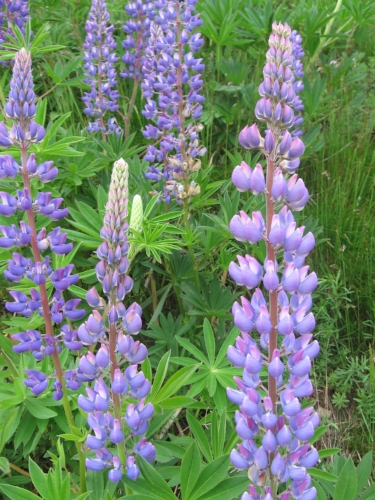Attracting Pollinators to Your Gardens
/A Bit of the Backstory
There has been lots of talk in the last few years about declining bee and monarch butterfly populations. While birds, bats and other insects and small mammals contribute to the process, bees are responsible for most of the pollinating that happens to the plants that not only provide us with a colourful display of flowers, but also the plants that provide us with much of what we humans consume.
Monarchs, for their part, do help to pollinate some flowers too, but, more than that, they have become the darling of our butterfly world. Their life cycle, the other worldly gold spots on the monarch chrysalis, and the phenomenal annual migration to Mexico and back have become a rite of passage in the learning of many Ontario kids. In all stages of their life cycle they bring beauty and wonder to our gardens.
Why are Some of Our Pollinators in Decline?
Neonicotinoids (‘neonics’), a class of insecticides used to coat crop seeds to prevent pest damage, have been found to be the culprit for much of the bee losses in North America. Some countries in Europe have now banned the use of neonics, and, for its part, Ontario introduced legislation in 2015 to limit the use of neonics here. But the damage has been done and bee populations are significantly down. So, in an effort to rejuvenate the bee population, gardeners, environmental organizations, and community groups are making special efforts to grow flowers that bring back the bees. Even General Mills, with their Cheerios promotion, are giving away free wildflower seeds.
While the decline in bee populations has been largely due to the use of these insecticides, the decline in the monarch butterfly population appears to be threefold; illegal logging of the fir trees where the monarchs overwinter in Mexico, climate change, and loss of milkweed habitats in southern Canada and the U.S.
So what can we do about threats to pollinators? I think the most important thing we can do is to stay informed, as the known threats to bees and monarchs develop and evolve. The issues affecting the health of our pollinators change rapidly. Think about it, until recently OMAFRA, the Ontario Ministry of Agriculture, Farming and Rural Affairs, listed milkweed as a noxious weed and fines could be imposed for having milkweed on your property. Now local governments support the planting of milkweed on private properties to encourage the growth of habitat for monarch butterflies.
So What to Plant?
You will hear, over and over again, plant native plants. Why? Because the pollinators that we are trying to attract have evolved over time to feed on native plants, and, in some cases, use these plants to lay eggs on. It's all part of complex ecosystems that we shouldn't try to mess with. Using monarchs as an example, they will only lay their eggs on milkweed. Period. There’s no tricking them into laying eggs on any other plant. They just won’t. While monarch butterflies will feed on many types of flowers, caterpillars need to feed on milkweed to grow and thrive.
Bees, for their part, are generally attracted to blue, purple and yellow flowers, although they will feed on the nectar and pollen of other colours of flowers as well.
Here’s a short list of perennials, shrubs and trees that will bring bees and butterflies to your garden from spring right through until the first frost in the fall. The botanical name is first, with a common name in parentheses afterward.
Achillea (yarrow)
Amelanchier (serviceberry)
Asclepias incarnata (swamp milkweed)
Asclepias syriaca (common milkweed)
Asclepias tuberosa (butterfly milkweed)
Asclepias verticillata (whorled milkweed)
Aster (aster)
Buddleia (butterfly bush)
Caryopteris (bluebeard)
Cercis (redbud)
Chelone (turtlehead)
Coreopsis (tickseed)
Echinacea (coneflower)
Eupotorium (Joe pye weed)
Hypericum (St. John’s wort)
Lonicera (honeysuckle)
Lupinus (lupin)
Malus (crabapple)
Monarda (beebalm)
Oenothera (evening primrose)
Penstemon (beardtongue)
Prunus virginiana (chokecherry)
Rudbeckia (black eyed Susan)
Sambucus (elderberry)
Sedum (stonecrop)
For an inexpensive hit of flowers you can try to grow many of these from seed, but I find it well worth the investment to buy plants already grown to a good size by local growers. Most of the plants listed above are perennials, and the ones that aren't (milkweed and lupin specifically) you can let go to seed in your garden so that new plants will come up on their own in future years.
Bees and butterflies are also attracted to many annuals and herbs, including those listed below:
Annuals
Lobularia maritima (sweet alyssum)
Cosmos bipinnatus (cosmos)
Helianthus (sunflower)
Heliotrope
Lantana
Tagetes (marigolds)
Zinnia (zinnias)
Herbs
Tanacetum vulgare (tansy)
Anethum graveolens (dill)
Levisticum officinale (lovage)
Angelica, Angelica (angelica)
Mentha (mint - in pots only!!!)
Coriandrum sativum (cilantro)
Agastache foeniculum (anise hyssop)
Origanum vulgare (oregano)
Tanacetum parthenium (feverfew)
Lavandula (lavender)
Thymus (thyme)
Foeniculum vulgare (fennel)
Petroselinum crispum (parsley)
Remember as well, vegetables and fruit trees are great attracters of pollinators, and will help to feed your family too!



